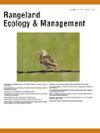阿根廷查科干旱地区畜禽连续放牧与水源距离的植物功能群分布
IF 2.4
3区 环境科学与生态学
Q2 ECOLOGY
引用次数: 0
摘要
在干旱的查科大草原,牲畜永久水源的存在影响了放牧的空间格局,产生了放牧强度的梯度,影响了植物群落的组成和生态系统的功能。植物物种的特性导致了物种对环境刺激的特异性反应。这些特征可以将物种划分为不同的功能植物群,这些功能植物群决定了各种干扰对生态系统功能的影响。在此背景下,我们的研究提出了一个假设,即与永久水源相关的连续放牧产生了累积的牲畜压力,这决定了不同地貌单元中植物群落的不同生态条件。在此假设下,我们做出以下预测:1)水源的分布直接或间接影响功能植物类群的空间分布;2)饲料资源质量的变化与某些功能植物类群的分布有关。定义了5个植物功能类群:一年生非饲料草本植物、多年生非饲料草本植物、饲料木本植物、饲料草本植物和非饲料木本植物。受影响显著的植物功能群是与饲料草本植物和非饲料木本植物生产相关的功能群。在研究的地貌单元中,植物功能群的贡献与植物群落的牧草质量之间的关系表明,牧草与植物群落的牧草质量呈正相关,而非牧草木本植物与植物群落的牧草质量呈负相关。在冲积平原1 250 m以上和丘陵1 900 m以上,牧草生长显著增加。研究结果可为本研究地区半干旱平原畜牧业水源分布规划提供参考。本文章由计算机程序翻译,如有差异,请以英文原文为准。
Distribution of Plant Functional Groups in Relation to Continuous Grazing and Distance to Water Sources for Livestock in the Arid Chaco, Argentina
In the Arid Chaco savannahs, the presence of permanent water sources for livestock affects the spatial patterns of grazing, generating a gradient of grazing intensity that affects the composition of plant communities and the functioning of the ecosystem. The characteristics of plant species give rise to species-specific responses to environmental stimuli. These characteristics can group species into different functional plant groups that determine the effect of various disturbances on the functioning of the ecosystem. In this context, our study proposes the hypothesis that continuous grazing associated with permanent water sources generates a cumulative livestock pressure that determines different ecological conditions for plant communities in different geomorphological units. Under this hypothesis, we make the following predictions: 1) The distribution of water sources directly and indirectly influences the spatial distribution of functional plant groups, and 2) Variation in the quality of forage resources is associated with the distribution of some functional plant groups. Five plant functional groups were defined: annual nonfodder herbaceous plants, perennial nonfodder herbaceous plants, fodder woody plants, fodder herbaceous plants, and nonfodder woody plants. The plant functional groups significantly affected were those related to the production of fodder herbaceous plants and nonfodder woody plants. The relationship between the contribution of the functional groups of plants and the forage quality of the plant communities in the geomorphological units studied shows that forage grasses have a positive relationship and nonforage woody plants have a negative relationship. At distances greater than 1 250 m in the alluvial plain and 1 900 m in the foothills, the growth of forage species increase significantly. This can serve as a reference for planning the distribution of water sources for livestock in semi-arid plains, such as the area studied.
求助全文
通过发布文献求助,成功后即可免费获取论文全文。
去求助
来源期刊

Rangeland Ecology & Management
农林科学-环境科学
CiteScore
4.60
自引率
13.00%
发文量
87
审稿时长
12-24 weeks
期刊介绍:
Rangeland Ecology & Management publishes all topics-including ecology, management, socioeconomic and policy-pertaining to global rangelands. The journal''s mission is to inform academics, ecosystem managers and policy makers of science-based information to promote sound rangeland stewardship. Author submissions are published in five manuscript categories: original research papers, high-profile forum topics, concept syntheses, as well as research and technical notes.
Rangelands represent approximately 50% of the Earth''s land area and provision multiple ecosystem services for large human populations. This expansive and diverse land area functions as coupled human-ecological systems. Knowledge of both social and biophysical system components and their interactions represent the foundation for informed rangeland stewardship. Rangeland Ecology & Management uniquely integrates information from multiple system components to address current and pending challenges confronting global rangelands.
 求助内容:
求助内容: 应助结果提醒方式:
应助结果提醒方式:


